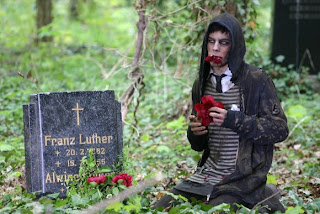The wonderful world of
Hollywood (and Not Quite Hollywood) Comedies.

Somehow lately, with a few well chosen exceptions, all my cinema outings have been to see concept comedies. Baby Mama, Tropic Thunder, the return of Harold and Kumar and the occasional deviation into the DVD territories of Semi Pro and Get Smart
and Get Smart . I have heart felt anticipation for House Bunny (which I am convinced will be great) and Step Brothers. I was convinced that the later would be less than great until actually sitting through an episode of Rove, which is usually repulsive, just for the track-short wonders of Will and John C. I am also itching to get out to see Seth Rogen in what is surely a stoner tour de force in Pineapple Express.
. I have heart felt anticipation for House Bunny (which I am convinced will be great) and Step Brothers. I was convinced that the later would be less than great until actually sitting through an episode of Rove, which is usually repulsive, just for the track-short wonders of Will and John C. I am also itching to get out to see Seth Rogen in what is surely a stoner tour de force in Pineapple Express.
Im not sure why these star vehicle comedies appeal to me so much (apart from the obvious break from rigorous academic they currently supply me with). I guess the impulse to entertainment lite, easy on the eyes, cortex and conscience, hits the basic appeals of entertainment. Add to this the often ambitious budgets of a film like Tropic Thunder and comedy becomes something that rests much closer to high concept than ever before. Simply, the gags have the scope to be more spectacular and funny than ever before. They can wreck cars, have people performing unimaginable CGI stunts and create psychedelic landscapes of interior life in unprecedented ways.
But wait. It was all done before – as Mark Hartley’s charming documentary Not Quite Hollywood chronicles. In my opinion exploitation has always made for the best comedy – collapsing the boundaries of body, mind, culture and taste into an anything-goes ensemble. Their comedy is created through rampant generic quotation, oddball characters and seemingly anarchic production, ambitious makeshift stunts, without the reason or rigour of safety standards, create an energy that could only be dreamed of by contemporary studio comedies
chronicles. In my opinion exploitation has always made for the best comedy – collapsing the boundaries of body, mind, culture and taste into an anything-goes ensemble. Their comedy is created through rampant generic quotation, oddball characters and seemingly anarchic production, ambitious makeshift stunts, without the reason or rigour of safety standards, create an energy that could only be dreamed of by contemporary studio comedies
I was really pleased to see this exposition of the traditions of exploitation and genre film in Australia, which created a great history of the genre through talking heads of its makers, stars, stuffy critics and gushing fans (such as the compelling Quentin Tarantino in an excellent big-name cameo, one of few that seemed genuinely conscripted out of passion rather than to bolster ticket sales). As with most documentaries, its primary source, the many and varied film clips, provided its most interesting material from which, hopefully, we will see a flow on into greater DVD releases (come on Umbrella!)
Blooming Marvelous!

Baby Mama: Fey and Poehler are charmers, but as usual the trivial consumerism of American women and their quest for babies is less comic so much as a cultural horror show. While the comedy was obviously critical, it left a bad taste in my mouth (which may or may not have been poop).
Fey and Poehler are charmers, but as usual the trivial consumerism of American women and their quest for babies is less comic so much as a cultural horror show. While the comedy was obviously critical, it left a bad taste in my mouth (which may or may not have been poop).
***
Tropic Thunder: A surprisingly excellent jungle escapade. The self reflexive making of the movie plot had some genius moments, allowing the joke set-ups to show great variety within a contained narrative. The cast was great, managing to balance one-trick-pony Stiller with finesse. Even the possibly concerning black-face Downey Junior proved to be cringelessly comedic. The film gets an extra star for a ‘Tour of Duty’ come ‘Good Morning Vietnam’ soundtrack with prerequisite Credence Clearwater Revival.
A surprisingly excellent jungle escapade. The self reflexive making of the movie plot had some genius moments, allowing the joke set-ups to show great variety within a contained narrative. The cast was great, managing to balance one-trick-pony Stiller with finesse. Even the possibly concerning black-face Downey Junior proved to be cringelessly comedic. The film gets an extra star for a ‘Tour of Duty’ come ‘Good Morning Vietnam’ soundtrack with prerequisite Credence Clearwater Revival.
****
Harold and Kumar Escape from Guantanamo Bay: They smoke some weed, get mistaken for terrorists, fall in love, see Dougie Howser M.D. and end up in the utopia of Amsterdam. Amusing, but lacks the pity cross-cultural satire that made the first film a comedy classic.
They smoke some weed, get mistaken for terrorists, fall in love, see Dougie Howser M.D. and end up in the utopia of Amsterdam. Amusing, but lacks the pity cross-cultural satire that made the first film a comedy classic.
**
Not Quite Hollywood:
****










